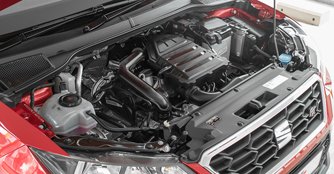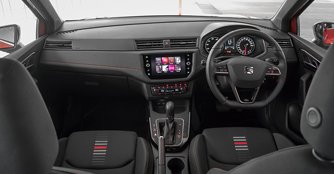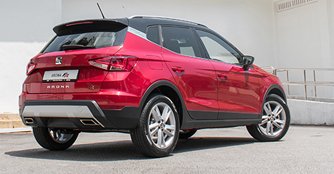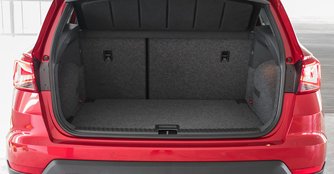Seat Arona 1.0 EcoTSI DSG FR (A) Review
02 Apr 2018|47,004 views
What We Like
Simple but stylish-looking
Engine is perkier than you'd expect
Ride is generally pliant
Frugal fuel consumption at 12.8km/L
Has a sizeable 400-litre boot
What We Dislike
Choice of cabin materials can be improved
Disadvantaged by the fact that Seat ins't as recognised yet in Singapore
The Volkswagen Group has been a little slow in joining the increasingly congested class of compact crossovers where the likes of Ford, Mazda, Nissan, Peugeot, Renault and others are already well-represented.
Apart from the much more expensive Porsche Macan, and until the Audi Q2 and the Volkswagen T-Roc surfaced, the Group's only offensive on this front was the Skoda Yeti. But now, it has included the Seat Arona into its mix, which sits under its Spanish brand's first effort, the Ateca.
Amid today's new wave of compact crossovers, the Arona has an uphill task of fending off more brand-established rivals, which include the Citroen C3 Aircross, the Hyundai Kona and the Toyota C-HR.
Size doesn't matter
The Arona is built on the Group's new small car platform, known as MQB A0, which also underpins the Seat Ibiza and the Volkswagen Polo compact hatchbacks.
That means it's quite small, measuring just 4,138mm x 1,780mm x 1,552mm (L x W x H). At $98,900 (as of 2nd April 2018), it faces the risk of buyers looking instead at bigger cars of similar price points.
But what it lacks in size is definitely made up for elsewhere, like its turbocharged 1.0-litre engine, for example. Similar to other 1.0-litres in the Group, this 114bhp unit is gutsier than you might imagine thanks to 200Nm of torque. Thus, it's never uncomfortably slow on the move.

 Not the first name in refinement but the Arona's turbocharged 1.0-litre packs enough punch for daily commutes
Not the first name in refinement but the Arona's turbocharged 1.0-litre packs enough punch for daily commutes
It's smooth once you get up to speed but admittedly a little hesitant when pulling away, and whirry if you push it too hard.
Thankfully, it's paired to a smooth-shifting dual-clutch transmission that allows for manual override via paddle shifters, and drive mode selection - sport, normal or eco. More importantly, the pairing easily allows for fuel consumption of 12.8km/L even with the occasional heavy right foot.
New drivers will also appreciate that the Arona is very easy to drive thanks to its small footprint, decent visibility all around and its comfortable ride.
Apart from the much more expensive Porsche Macan, and until the Audi Q2 and the Volkswagen T-Roc surfaced, the Group's only offensive on this front was the Skoda Yeti. But now, it has included the Seat Arona into its mix, which sits under its Spanish brand's first effort, the Ateca.
Amid today's new wave of compact crossovers, the Arona has an uphill task of fending off more brand-established rivals, which include the Citroen C3 Aircross, the Hyundai Kona and the Toyota C-HR.
Size doesn't matter
The Arona is built on the Group's new small car platform, known as MQB A0, which also underpins the Seat Ibiza and the Volkswagen Polo compact hatchbacks.
That means it's quite small, measuring just 4,138mm x 1,780mm x 1,552mm (L x W x H). At $98,900 (as of 2nd April 2018), it faces the risk of buyers looking instead at bigger cars of similar price points.
But what it lacks in size is definitely made up for elsewhere, like its turbocharged 1.0-litre engine, for example. Similar to other 1.0-litres in the Group, this 114bhp unit is gutsier than you might imagine thanks to 200Nm of torque. Thus, it's never uncomfortably slow on the move.

It's smooth once you get up to speed but admittedly a little hesitant when pulling away, and whirry if you push it too hard.
Thankfully, it's paired to a smooth-shifting dual-clutch transmission that allows for manual override via paddle shifters, and drive mode selection - sport, normal or eco. More importantly, the pairing easily allows for fuel consumption of 12.8km/L even with the occasional heavy right foot.
New drivers will also appreciate that the Arona is very easy to drive thanks to its small footprint, decent visibility all around and its comfortable ride.
Sensible Spaniard
On the inside, the Arona's cabin design is less sombre than those of Volkswagen's with contrasting red on black stitching adding a welcoming splash of colour, which reflects the brands positioning in the Group.
Layout of the dashboard, too, deserves praise for high functionality (well laid out, logical and clear) as well as an 8.0-inch touchscreen monitor that's crisp, bright and responds quickly.

 Not the best of cabin materials used but design is straightforward and funky pops of colour are welcoming
Not the best of cabin materials used but design is straightforward and funky pops of colour are welcoming
The cabin is, however, finished in less plush materials. The leather of choice for the steering wheel and door plastics, for example, are unexceptional.
But if you're not picky about these things, the Arona is a proper family car. It can very comfortably transport a family of four (five can be a bit of squeeze) with considerably more rear legroom than the Hyundai Kona.
And most importantly, Seat has triumphed where so many others don't by building a compact crossover with a big boot. Its 400-litre boot offers more luggage space than a Volkswagen Golf, as well as a square opening and a dual-height boot floor to divide the load space.
For its price, there really is little to complain about the Arona. It's something different and offers just the right amount of space, pace and grace. Seat's biggest challenge with this car, then, is hoping people recognise and accept it, for it really is a diamond in the rough.
On the inside, the Arona's cabin design is less sombre than those of Volkswagen's with contrasting red on black stitching adding a welcoming splash of colour, which reflects the brands positioning in the Group.
Layout of the dashboard, too, deserves praise for high functionality (well laid out, logical and clear) as well as an 8.0-inch touchscreen monitor that's crisp, bright and responds quickly.

The cabin is, however, finished in less plush materials. The leather of choice for the steering wheel and door plastics, for example, are unexceptional.
But if you're not picky about these things, the Arona is a proper family car. It can very comfortably transport a family of four (five can be a bit of squeeze) with considerably more rear legroom than the Hyundai Kona.
And most importantly, Seat has triumphed where so many others don't by building a compact crossover with a big boot. Its 400-litre boot offers more luggage space than a Volkswagen Golf, as well as a square opening and a dual-height boot floor to divide the load space.
For its price, there really is little to complain about the Arona. It's something different and offers just the right amount of space, pace and grace. Seat's biggest challenge with this car, then, is hoping people recognise and accept it, for it really is a diamond in the rough.
What We Like
Simple but stylish-looking
Engine is perkier than you'd expect
Ride is generally pliant
Frugal fuel consumption at 12.8km/L
Has a sizeable 400-litre boot
What We Dislike
Choice of cabin materials can be improved
Disadvantaged by the fact that Seat ins't as recognised yet in Singapore
The Volkswagen Group has been a little slow in joining the increasingly congested class of compact crossovers where the likes of Ford, Mazda, Nissan, Peugeot, Renault and others are already well-represented.
Apart from the much more expensive Porsche Macan, and until the Audi Q2 and the Volkswagen T-Roc surfaced, the Group's only offensive on this front was the Skoda Yeti. But now, it has included the Seat Arona into its mix, which sits under its Spanish brand's first effort, the Ateca.
Amid today's new wave of compact crossovers, the Arona has an uphill task of fending off more brand-established rivals, which include the Citroen C3 Aircross, the Hyundai Kona and the Toyota C-HR.
Size doesn't matter
The Arona is built on the Group's new small car platform, known as MQB A0, which also underpins the Seat Ibiza and the Volkswagen Polo compact hatchbacks.
That means it's quite small, measuring just 4,138mm x 1,780mm x 1,552mm (L x W x H). At $98,900 (as of 2nd April 2018), it faces the risk of buyers looking instead at bigger cars of similar price points.
But what it lacks in size is definitely made up for elsewhere, like its turbocharged 1.0-litre engine, for example. Similar to other 1.0-litres in the Group, this 114bhp unit is gutsier than you might imagine thanks to 200Nm of torque. Thus, it's never uncomfortably slow on the move.

 Not the first name in refinement but the Arona's turbocharged 1.0-litre packs enough punch for daily commutesIt's smooth once you get up to speed but admittedly a little hesitant when pulling away, and whirry if you push it too hard.
Not the first name in refinement but the Arona's turbocharged 1.0-litre packs enough punch for daily commutesIt's smooth once you get up to speed but admittedly a little hesitant when pulling away, and whirry if you push it too hard.
Thankfully, it's paired to a smooth-shifting dual-clutch transmission that allows for manual override via paddle shifters, and drive mode selection - sport, normal or eco. More importantly, the pairing easily allows for fuel consumption of 12.8km/L even with the occasional heavy right foot.
New drivers will also appreciate that the Arona is very easy to drive thanks to its small footprint, decent visibility all around and its comfortable ride.
Apart from the much more expensive Porsche Macan, and until the Audi Q2 and the Volkswagen T-Roc surfaced, the Group's only offensive on this front was the Skoda Yeti. But now, it has included the Seat Arona into its mix, which sits under its Spanish brand's first effort, the Ateca.
Amid today's new wave of compact crossovers, the Arona has an uphill task of fending off more brand-established rivals, which include the Citroen C3 Aircross, the Hyundai Kona and the Toyota C-HR.
Size doesn't matter
The Arona is built on the Group's new small car platform, known as MQB A0, which also underpins the Seat Ibiza and the Volkswagen Polo compact hatchbacks.
That means it's quite small, measuring just 4,138mm x 1,780mm x 1,552mm (L x W x H). At $98,900 (as of 2nd April 2018), it faces the risk of buyers looking instead at bigger cars of similar price points.
But what it lacks in size is definitely made up for elsewhere, like its turbocharged 1.0-litre engine, for example. Similar to other 1.0-litres in the Group, this 114bhp unit is gutsier than you might imagine thanks to 200Nm of torque. Thus, it's never uncomfortably slow on the move.

Thankfully, it's paired to a smooth-shifting dual-clutch transmission that allows for manual override via paddle shifters, and drive mode selection - sport, normal or eco. More importantly, the pairing easily allows for fuel consumption of 12.8km/L even with the occasional heavy right foot.
New drivers will also appreciate that the Arona is very easy to drive thanks to its small footprint, decent visibility all around and its comfortable ride.
Sensible Spaniard
On the inside, the Arona's cabin design is less sombre than those of Volkswagen's with contrasting red on black stitching adding a welcoming splash of colour, which reflects the brands positioning in the Group.
Layout of the dashboard, too, deserves praise for high functionality (well laid out, logical and clear) as well as an 8.0-inch touchscreen monitor that's crisp, bright and responds quickly.

 Not the best of cabin materials used but design is straightforward and funky pops of colour are welcomingThe cabin is, however, finished in less plush materials. The leather of choice for the steering wheel and door plastics, for example, are unexceptional.
Not the best of cabin materials used but design is straightforward and funky pops of colour are welcomingThe cabin is, however, finished in less plush materials. The leather of choice for the steering wheel and door plastics, for example, are unexceptional.
But if you're not picky about these things, the Arona is a proper family car. It can very comfortably transport a family of four (five can be a bit of squeeze) with considerably more rear legroom than the Hyundai Kona.
And most importantly, Seat has triumphed where so many others don't by building a compact crossover with a big boot. Its 400-litre boot offers more luggage space than a Volkswagen Golf, as well as a square opening and a dual-height boot floor to divide the load space.
For its price, there really is little to complain about the Arona. It's something different and offers just the right amount of space, pace and grace. Seat's biggest challenge with this car, then, is hoping people recognise and accept it, for it really is a diamond in the rough.
On the inside, the Arona's cabin design is less sombre than those of Volkswagen's with contrasting red on black stitching adding a welcoming splash of colour, which reflects the brands positioning in the Group.
Layout of the dashboard, too, deserves praise for high functionality (well laid out, logical and clear) as well as an 8.0-inch touchscreen monitor that's crisp, bright and responds quickly.

But if you're not picky about these things, the Arona is a proper family car. It can very comfortably transport a family of four (five can be a bit of squeeze) with considerably more rear legroom than the Hyundai Kona.
And most importantly, Seat has triumphed where so many others don't by building a compact crossover with a big boot. Its 400-litre boot offers more luggage space than a Volkswagen Golf, as well as a square opening and a dual-height boot floor to divide the load space.
For its price, there really is little to complain about the Arona. It's something different and offers just the right amount of space, pace and grace. Seat's biggest challenge with this car, then, is hoping people recognise and accept it, for it really is a diamond in the rough.
Also read our comparison article on:
Seat Arona 1.0 vs Kia Stonic 1.0TCar Information
SEAT Arona 1.0 EcoTSI DSG FR (A)
CAT A|Petrol|20km/L
Horsepower
85kW (114 bhp)
Torque
200 Nm
Acceleration
10sec (0-100km /hr)
This model is no longer being sold by local distributor
All Used SEAT AronaThank You For Your Subscription.









































